Khust
Khust (Ukrainian: Хуст, German: Chust, Hungarian: Huszt, Rusyn: Хуст) is a city located on the Khustets River in Zakarpattia Oblast (province) in western Ukraine. It is near the сonfluence of the Tisa and Rika Rivers. Serving as the administrative center of Khust Raion (district), the city itself does not belong to the raion and is designated as a city of oblast significance, with the status equal to that of a raion. Population: 28,448 (2016 est.)[1]
Khust Хуст Huszt | |
|---|---|
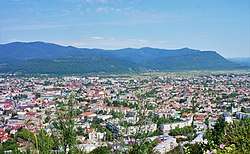 Panorama of Khust from the Castle Hill | |
 Flag 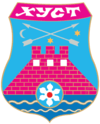 Coat of arms | |
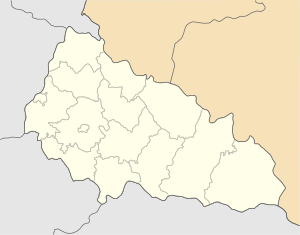 Khust Location of Khust  Khust Khust (Ukraine) | |
| Coordinates: 48°10′53″N 23°17′52″E | |
| Country | |
| Oblast | |
| Raion | Khust city council |
| Founded | 1090 |
| Incorporated | 1324 |
| Government | |
| • Mayor | Volodymyr Kashchuk |
| Elevation | 164 m (538 ft) |
| Population (2016) | |
| • City of regional significance | 28,448 |
| • Density | 1,298.140/km2 (3,362.17/sq mi) |
| • Metro | 31,864 |
| Time zone | UTC+1 (CET) |
| • Summer (DST) | UTC+2 (CEST) |
| Postal code | 90400 |
| Area code(s) | +380-3142 |
| Climate | Cfb |
| Website | Official Website |
Khust was the capital of the short-lived republic of Carpatho-Ukraine.
Origin of name
The name is most possibly related to the name of the stream Hustets or Husztica, whose meaning is "kerchief". It is also conceivable that the name of the city comes from a Romanian traditional food ingredient – husti.
There are several alternative names used for this city: Ukrainian /Rusyn: Хуст, Romanian: Hust, Hungarian: Huszt, Czech and Slovak: Chust, Yiddish: חוסט, German: Chust.
There is also one fairy tale about the town's name: Once chort was walking around the town and then mountain had appeared. A moment later, it fell down on his tail. He shouted “Hvust” (Transcarpathian dialect, “Хвіст” in Ukrainian, “Tail” in English). Another chort heard “Khust” … In that way, the name of the town was formed.
History
The settlement was first mentioned as terra Huzth, in 1324.[2] Its castle, supposed to be built in 1090 by king St. Ladislaus of Hungary as a defence against the Cumans and destroyed during the Mongol invasion of Hungary, was mentioned in 1353. The town got privileges in 1329.[3]
In 1458 King Matthias imprisoned his uncle, the rebellious Mihály Szilágyi in the castle. In 1514, during György Dózsa's peasant revolt local peasants captured the castle. In 1526 the area became a part of Transylvania.
The army of Ferdinand I captured the town in 1546. In 1594 the Tartars destroyed the town, but could not take the castle. The castle was besieged in 1644 by the army of George I Rákóczi, in 1657 by the Polish, in 1661–62 by the Ottoman and Tartar hordes. Count Ferenc Rhédey, the ruling prince of Transylvania and high steward of Máramaros county died in the castle on May 13, 1667.
The castle surrendered to the Kurucs on August 17, 1703, and the independence of Transylvania was proclaimed here. It was the last castle the Habsburgs occupied when suppressing the freedom fight of the Kurucs, in 1711. The seriously damaged castle was struck by lightning and burnt down on July 3, 1766; a storm brought down its tower in 1798, it has been in ruins ever since then. Khust was renamed as Csebreny in 1882 during Magyarization process.
In 1910 Khust had 10,292 citizens, 5,230 Ruthenians, 3,505 Hungarians and 1,535 Germans. Until the Treaty of Trianon it belonged to Hungary and was the seat of the Khust district of Máramaros county. After World War I, in summer 1919 the Rumanian troops took over the territory. But according to the St.-Germain treaty Czechoslovakia received the city, as part of newly formed Podkarpatsko ("under the Carpathians") region (Subcarpathia).[4] Czechoslovakia had to provide the region a wide autonomy, but autonomy was realised only in 1938. In Autumn 1938 an autonomous government was organised. The day after the collapse of Czechoslovakia on March 14, 1939, the Khust city government proclaimed, by the will of the local population, independence as Carpathian Ukraine on March 15, 1939. Next day, on March 16, 1939, Hungarian troops invaded Khust and claimed it as part of Hungary. On October 24, 1944, Soviet troops occupied the city, and annexed it into the Soviet Union. The Soviet government deported much of the city's German and Hungarian populations.
WWII and the Holocaust
Prior to 1939, Jews thrived in Khust and owned many businesses. When the city became part of Hungary in March 1939 again, many Jewish citizens were forced into labor camps. A ghetto was established, and Jews from other regions were forced to live there. Additional ghettos were established neaby in Iza and Szeklence (toda Sokyrnycia, Ukraine).[5] By April 1944[6], all Jewish residents were killed at Auschwitz.[7][8]

Prior to the war, there were 8 synagogues in the city. One, built in the 19th century, survives and is in use today.[5] A "twin" synagogue was destroyed by the Soviets after the war.[9]
Yeshiva
In 1861, Rabbi Moshe Schick, known as the "Maharam Schick" established – what was at that time – the largest yeshiva (Torah academy) in Eastern Europe, in Khust. This yeshiva had over 800 students.
Rabbis

- Grand Rabbi Yosef Tzvi Dushinsky (first Dushinsky rebbe), (later the chief Rabbi of Jerusalem) was the Town Chief Rabbi, and was the Dean of one of the foremost Orthodox Jewish Seminaries, the Maharam Shiek Yeshiva.
- Grand Rabbi Moshe Greenwald, author of Arugas Habosem, a book of responsa, was the Rav from 1887–1910; the Chust yeshiva experienced tremendous growth under his leadership.
- Rabbi Yehoshua Greenwald, grandson of Rabbi Moshe Greenwald, served as Rav until the deportation of the community to Auschwitz during World War II. After the war, he established a congregation for Chust Holocaust survivors in the Borough Park section of Brooklyn which his son-in-law Grand Rabbi Pinchos Dovid Horowitz, eldest son of Levi Yitzchak Horowitz the Bostoner Rebbe, now leads. Grand Rabbi Pinchos Dovid Horowitz of Chust-Borough Park
- Rabbi Yehoshua Greenwald, grandson of Rabbi Moshe Greenwald, served as Rav until the deportation of the community to Auschwitz during World War II. After the war, he established a congregation for Chust Holocaust survivors in the Borough Park section of Brooklyn which his son-in-law Grand Rabbi Pinchos Dovid Horowitz, eldest son of Levi Yitzchak Horowitz the Bostoner Rebbe, now leads.
Hasidic Rebbes of the Nadvorna dynasty
- Grand Rabbi Yisroel Yaakov Leifer, youngest son and Successor by declaration of Rabbi Mordechai of Nadvorna.
- Grand Rabbi Shmuel Shmelke Leifer, son of Rebbe Yisroel Yaakov, author of the Beis Shmuel.
- Grand Rabbi Reuven Leifer of Viezer, son of Rebbe Yisroel Yaakov
- Grand Rabbi Dovid Leifer of Groirverdan, son of Rebbe Yisroel Yaakov
- Grand Rabbi Levi of Chust-Tosh
- Grand Rabbi Aharon Moishe Leifer, son of Rabbi Shmuel Shmelke.
- Grand Rabbi Shmuel Shmelka Leifer II of Chust
- Grand Rabbi Baruch Pinchos Leifer of Chust-Israel
- Grand Rabbi Turnauer of Chust-Williamsburg
- Grand Rabbi Meshullam Ginsberg of Chust, grandson and successor of Grand Rabbi Levi of Chust-Tosh
Demographics
In 2001 it had 31,900 inhabitants, including:[10]
- 28,500 (89.3%) Ukrainians
- 1,700 (5.4%) Hungarians
- 1,200 (3.7%) Russians
- 100 (0.4%) Roma
Until the 19th century the city's population also included ethnic Romanians (800 Romanians according to the 1880 census).
Climate
Khust has an oceanic climate (Köppen: Cfb).
| Climate data for Khust | |||||||||||||
|---|---|---|---|---|---|---|---|---|---|---|---|---|---|
| Month | Jan | Feb | Mar | Apr | May | Jun | Jul | Aug | Sep | Oct | Nov | Dec | Year |
| Daily mean °C (°F) | −2.8 (27.0) |
−0.6 (30.9) |
4.4 (39.9) |
10.2 (50.4) |
15.1 (59.2) |
18.0 (64.4) |
19.6 (67.3) |
19.2 (66.6) |
15.3 (59.5) |
10.1 (50.2) |
4.3 (39.7) |
−0.1 (31.8) |
9.4 (48.9) |
| Average precipitation mm (inches) | 47 (1.9) |
41 (1.6) |
41 (1.6) |
50 (2.0) |
74 (2.9) |
93 (3.7) |
80 (3.1) |
72 (2.8) |
48 (1.9) |
45 (1.8) |
52 (2.0) |
62 (2.4) |
705 (27.7) |
| Source: Climate-Data.org[11] | |||||||||||||
Tourist sights
- Ruins of the Khust Castle
- Protestant fortress church 13th–14th century, Protestant since 1524, fortified in 1616, 1644, 1661 and 1670, restored in 1773 and 1888. Its belfry is from the 15th century; until 1861 it had four pinnacles.
- Roman Catholic church (Baroque, 18th century)
- Greek Orthodox church (18th century)
Famous people
- Jenő Benda, writer, journalist was born here in 1882.
- Leslie Buck (born Laszlo Büch), American business executive and Holocaust survivor, designer of the Anthora coffee cup, was born in Khust in 1922.[12][13]
- Myroslav Dochynets, Ukrainian writer was born here in 1959.
- Jaromír Hořec, Czech poet, writer and journalist was born here in 1921.
- József Koller, historian of religion was born here in 1745.
- Antonín Moskalyk, Czech film director was born here in 1930.
- Ernő Szép writer was born here in 1894.
- Count József Teleki scientist was born here on December 21, 1738.
- Veronica Vovchuk (born 1990), Queen of the World, an international top model and actress with their own cosmetics line, "Queen Veronica"
- Rabbi Zeev ben Moshe Feuerlicht (born 1918), studied in Romania, in yeshiva of Satu-Mare Rebbe, during the Liberation of Czechoslovakia from Nazi Germany he joined as an active fighter the Gen. Ludvík Svoboda Army, served in Prague synagogue Alt-neu Shul as a Rabbi, educator and shochet. Rabbi Feuerlicht should be credited for the survival of the Orthodox community in Czechoslovakia after WWII.
- Mikhailo Deyak, artist born in Zolotarevo
Gallery
 Monument at the entrance to the city |
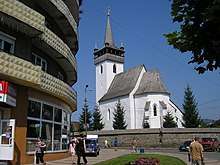 Gothic Reformed Fortress Church 13th Century |
 Castle ruins |
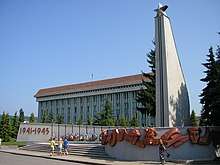 War memorial |
References
- "Чисельність наявного населення України (Actual population of Ukraine)" (PDF) (in Ukrainian). State Statistics Service of Ukraine. Retrieved 19 July 2016.
- Ivanciuc, Teofil. "Primele atestări ale târgurilor de coroană maramureşene (The earliest mentions of the Maramureş Royal Market Towns)". Revista Arhivei Maramureşene.
- Ivanciuc, Teofil. "Primele atestări ale târgurilor de coroană maramureşene (The earliest mentions of the Maramureş Royal Market Towns)". Revista Arhivei Maramureşene.
- PRECLÍK, Vratislav: "Profesor Masaryk a Podkarpatská Rus právě před sto lety" (Professor Masaryk and Subcarpatian Russia just hundred years ago), in Čas: časopis Masarykova demokratického hnutí, leden - březen 2019, roč.XXVII. čís. 125. ISSN 1210-1648, str.18 – 23
- Shtetl Routes. Vestiges of Jewish cultural heritage in cross-border tourism in borderland of Poland, Belarus and Ukraine
- https://dbs.bh.org.il/place/khust
- https://balkanist.net/the-last-jews-of-zakarpattia/
- https://www.jewishvirtuallibrary.org/khust
- https://jewish-heritage-europe.eu/2019/07/21/ukrainein-our-synagogue/
- "Archived copy". Archived from the original on 2007-09-11. Retrieved 2007-03-17.CS1 maint: archived copy as title (link)
- "Climate: Khust". Climate-Data.org. Retrieved 1 May 2014.
- Fox, Margalit (2010-04-29). "Leslie Buck, Designer of Iconic Coffee Cup, Dies at 87". New York Times. Retrieved 2010-05-31.
- "NY coffee cup creator Leslie Buck dies at 87". The Daily Telegraph. 2010-05-01. Retrieved 2010-06-05.
External links
- Khust in the Encyclopedia of Ukraine
- All about Khust City Includes a large image of the city and castle.
- Khust City elections in 2003
- Place names of Maramaros County